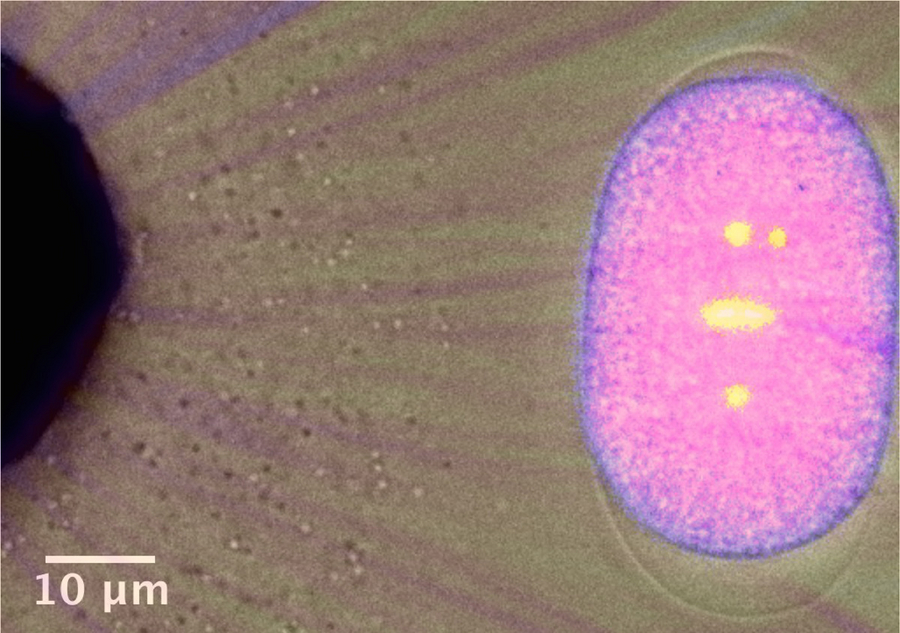
On the left: The magnetic tip that generates a magnetic gradient to move and generate force on superparamagnetic beads. The direction-projection lines that the beads follow are shown in the background. On the right: a single-cell C. elegans embryo in which the centrosomes and the chromosomes are fluorescently labelled. A superparamagnetic bead is positioned to the right of the upper centrosome.
Cell division is a basic process of life, in which it is crucial that the mitotic spindle is positioned and oriented correctly to inherit correctly all the necessary genetic material to the daughter cells. How large are the forces that maintain the mitotic spindle at the cell center? What are the relevant time scales? And how effective are the force generators at stabilizing the spindle against thermal and other fluctuations? These are questions that remained unanswered due to the difficulties of exerting and measuring forces generated by and acting upon spindles in intact cells. A team of researchers in Dresden managed to answer these questions by performing in vivo force measurements in dividing cells of the nematode C. elegans. They discovered that the mitotic spindle acts as compliant machinery that integrates forces from thousands of microtubules to accomplish a proper spindle positioning. The findings were published in Science.
While so far laser cutting, glass needle manipulation and other techniques had been the choice to measure forces in-vivo, the Dresden research team decided to go for a magnetic tweezer approach. They introduced magnetic particles into cells to exert calibrated forces directly to the mitotic spindle poles without disrupting other intracellular structures or physiological processes. By doing so, they measured the mitotic forces during cell division and discovered that the mitotic spindle acts as a force-generating apparatus that generates a “centering force” that maintains and possibly drives the spindle to the cell center. This is a classic example of how cells use the dynamics of a self-organised intracellular machinery to accomplish cell function – in this case spindle positioning.
The value of the measured centering force was surprisingly low given the size of the mitotic spindle: Only 20 pN per micron of displacement are generated by the machinery built up from thousands of individual microtubules. “It is like pushing an entire building made of steel with just one finger, but in this case the steel beams that made up the building are dynamic: they grow, shrink, and probably buckle constantly”, says Carlos Garzon-Coral, now at Stanford and at the time a PhD student in the lab of Jonathon Howard at the MPI-CBG. Garzon-Coral is the first author of the study.
The force generated by the discovered machinery is soft enough to quench thermal forces to make sure that the cell spindle maintains its position at the cell center, but low enough to allow force generators to fine-tune the position of the spindle – this is important if an asymmetric cell division needs to happen.
Carlos Garzon-Coral, Horatiu A. Fantana, Jonathon Howard:
A force-generating machinery maintains the spindle at the cell center during mitosis
Science, 26 May 2016